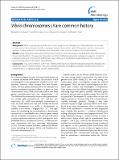| dc.contributor.author | Kirkup, Benjamin | |
| dc.contributor.author | Chang, LeeAnn | |
| dc.contributor.author | Chang, Sarah | |
| dc.contributor.author | Gevers, Dirk | |
| dc.contributor.author | Polz, Martin F. | |
| dc.date.accessioned | 2010-09-27T22:07:42Z | |
| dc.date.available | 2010-09-27T22:07:42Z | |
| dc.date.issued | 2010-05 | |
| dc.date.submitted | 2009-08 | |
| dc.identifier.issn | 1471-2180 | |
| dc.identifier.uri | http://hdl.handle.net/1721.1/58723 | |
| dc.description.abstract | Background: While most gamma proteobacteria have a single circular chromosome, Vibrionales have two circular chromosomes. Horizontal gene transfer is common among Vibrios, and in light of this genetic mobility, it is an open question to what extent the two chromosomes themselves share a common history since their formation. Results: Single copy genes from each chromosome (142 genes from chromosome I and 42 genes from chromosome II) were identified from 19 sequenced Vibrionales genomes and their phylogenetic comparison suggests consistent phylogenies for each chromosome. Additionally, study of the gene organization and phylogeny of the respective origins of replication confirmed the shared history. Conclusions: Thus, while elements within the chromosomes may have experienced significant genetic mobility, the backbones share a common history. This allows conclusions based on multilocus sequence analysis (MLSA) for one chromosome to be applied equally to both chromosomes. | en_US |
| dc.description.sponsorship | Woods Hole Center for Oceans & Human Health | en_US |
| dc.description.sponsorship | Gordon and Betty Moore Foundation | en_US |
| dc.description.sponsorship | United States. Dept. of Energy. Genomes To Life | en_US |
| dc.publisher | BioMed Central Ltd | en_US |
| dc.relation.isversionof | http://dx.doi.org/10.1186/1471-2180-10-137 | en_US |
| dc.rights | Creative Commons Attribution | en_US |
| dc.rights.uri | http://creativecommons.org/licenses/by/2.0 | en_US |
| dc.source | BioMed Central Ltd | en_US |
| dc.title | Vibrio chromosomes share common history | en_US |
| dc.type | Article | en_US |
| dc.identifier.citation | BMC Microbiology. 2010 May 10;10(1):137 | en_US |
| dc.contributor.department | Massachusetts Institute of Technology. Department of Civil and Environmental Engineering | en_US |
| dc.contributor.mitauthor | Polz, Martin F. | |
| dc.contributor.mitauthor | Kirkup, Benjamin | |
| dc.contributor.mitauthor | Chang, LeeAnn | |
| dc.relation.journal | BMC Microbiology | en_US |
| dc.eprint.version | Final published version | en_US |
| dc.identifier.pmid | 20459749 | |
| dc.type.uri | http://purl.org/eprint/type/JournalArticle | en_US |
| eprint.status | http://purl.org/eprint/status/PeerReviewed | en_US |
| dc.date.updated | 2010-09-03T16:23:01Z | |
| dc.language.rfc3066 | en | |
| dc.rights.holder | Kirkup et al.; licensee BioMed Central Ltd. | |
| dspace.orderedauthors | Kirkup, Benjamin C; Chang, LeeAnn; Chang, Sarah; Gevers, Dirk; Polz, Martin F | en |
| dc.identifier.orcid | https://orcid.org/0000-0001-9296-3733 | |
| dspace.mitauthor.error | true | |
| mit.license | PUBLISHER_CC | en_US |
| mit.metadata.status | Complete | |
